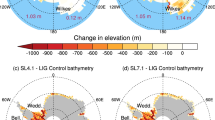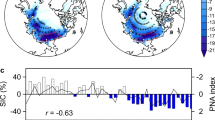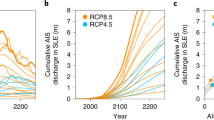Abstract
The Last Interglacial (LIG), a warmer period 130,000–116,000 years before present, is a potential analogue for future climate change. Stronger LIG summertime insolation at high northern latitudes drove Arctic land summer temperatures 4–5 °C higher than in the pre-industrial era. Climate model simulations have previously failed to capture these elevated temperatures, possibly because they were unable to correctly capture LIG sea-ice changes. Here, we show that the latest version of the fully coupled UK Hadley Center climate model (HadGEM3) simulates a more accurate Arctic LIG climate, including elevated temperatures. Improved model physics, including a sophisticated sea-ice melt-pond scheme, result in a complete simulated loss of Arctic sea ice in summer during the LIG, which has yet to be simulated in past generations of models. This ice-free Arctic yields a compelling solution to the long-standing puzzle of what drove LIG Arctic warmth and supports a fast retreat of future Arctic summer sea ice.
This is a preview of subscription content, access via your institution
Access options
Access Nature and 54 other Nature Portfolio journals
Get Nature+, our best-value online-access subscription
$29.99 / 30 days
cancel any time
Subscribe to this journal
Receive 12 print issues and online access
$209.00 per year
only $17.42 per issue
Buy this article
- Purchase on Springer Link
- Instant access to full article PDF
Prices may be subject to local taxes which are calculated during checkout




Similar content being viewed by others
Data availability
The CMIP3-6 model data used in this study to compute ECS and ice-free years are available from the Earth System Grid Federation (https://esgf-node.llnl.gov/). The HadCM3 and HadGEM3 model outputs used to support the findings of this study are available from http://gws-access.ceda.ac.uk/public/pmip4/vittoria/CMIP6LIG_HadGEM3_CMIP3_HadCM3/. The HadGEM3 model outputs prepared for CMIP6 can be found at https://doi.org/10.22033/ESGF/CMIP6.419 (ref. 54). The authors declare that all other data are available in the paper and its Supplementary Information.
Code availability
The source code of the HadCM3 model and the HadGEM3 model’s atmospheric component (Unified Model) is available under licence. To apply for a licence, go to http://www.metoffice.gov.uk/research/modelling-systems/unified-model. JULES is available under licence free of charge; see https://jules-lsm.github.io/. The NEMO model code is available from http://www.nemo-ocean.eu. The model code for CICE can be downloaded from https://code.metoffice.gov.uk/trac/cice/browser.
Change history
30 August 2023
A Correction to this paper has been published: https://doi.org/10.1038/s41558-023-01821-2
References
Kaspar, F., Kühl, N., Cubasch, U. & Litt, T. A model–data comparison of European temperatures in the Eemian interglacial. Geophys. Res. Lett. 32, L11703 (2005).
CAPE Last Interglacial Project Members. Last interglacial Arctic warmth confirms polar amplification of climate change. Quat. Sci. Rev. 25, 1382–1400 (2006).
Capron, E. et al. Temporal and spatial structure of multi-millennial temperature changes at high latitudes during the last interglacial. Quat. Sci. Rev. 103, 116–133 (2014).
Capron, E., Govin, A., Feng, R., Otto-Bliesner, B. L. & Wolff, E. W. Critical evaluation of climate syntheses to benchmark CMIP6/PMIP4 127 ka last interglacial simulations in the high-latitude regions. Quat. Sci. Rev. 168, 137–150 (2017).
Hoffman, J. S., Clark, P. U., Parnell, A. C. & He, F. Regional and global sea-surface temperatures during the last interglaciation. Science 355, 276–279 (2017).
Kopp, R. E., Simons, F. J., Mitrovica, J. X., Maloof, A. C. & Oppenheimer, M. Probabilistic assessment of sea level during the last interglacial stage. Nature 462, 863–867 (2009).
Dutton, A. et al. Sea-level rise due to polar ice-sheet mass loss during past warm periods. Science 349, aaa4019 (2015).
Malmierca-Vallet, I. et al. Simulating the last interglacial Greenland stable water isotope peak: the role of arctic sea ice changes. Quat. Sci. Rev. 198, 1–14 (2018).
Masson-Delmotte, V. et al. Sensitivity of interglacial Greenland temperature and δ18o: ice core data, orbital and increased CO2 climate simulations. Climate 7, 1041–1059 (2011).
Otto-Bliesner, B. L. et al. How warm was the last interglacial? New model–data comparisons. Phil. Trans. R. Soc. A 371, 20130097 (2013).
Lunt, D. J. et al. A multi-model assessment of last interglacial temperatures. Climate 9, 699–717 (2013).
Sime, L. C. et al. Warm climate isotopic simulations: what do we learn about interglacial signals in Greenland ice cores? Quat. Sci. Rev. 67, 59–80 (2013).
Stein, R., Fahl, K., Gierz, P., Niessen, F. & Lohmann, G. Arctic Ocean sea ice cover during the penultimate glacial and the last interglacial. Nat. Commun. 8, 373 (2017).
Brigham-Grette, J. & Hopkins, D. M. Emergent marine record and paleoclimate of the last interglaciation along the northwest Alaskan coast. Quat. Res. 43, 159–173 (1995).
Nørgaard-Pedersen, N., Mikkelsen, N., Lassen, S. J., Kristoffersena, Y. & Sheldon, E. Reduced sea ice concentrations in the Arctic Ocean during the last interglacial period revealed by sediment cores off northern Greenland. Paleoceanography 22, PA1218 (2007).
Adler, R. E. et al. Sediment record from the western Arctic Ocean with an improved Late Quaternary age resolution: HOTRAX core HLY0503-8JPC, Mendeleev Ridge. Glob. Planet. Change 68, 18–29 (2009).
Cronin, T. et al. Quaternary sea-ice history in the Arctic Ocean based on a new ostracode sea-ice proxy. Quat. Sci. Rev. 29, 3415–3429 (2010).
Belt, S. Source-specific biomarkers as proxies for Arctic and Antarctic sea ice. Org. Geochem. 125, 277–298 (2018).
Otto-Bliesner, B. L. et al. Simulating Arctic climate warmth and icefield retreat in the last interglaciation. Science 311, 1751–1753 (2006).
Tatebe, H. et al. Description and basic evaluation of simulated mean state, internal variability, and climate sensitivity in MIROC6. Geosci. Model Dev. 12, 2727–2765 (2019).
Wu, T. et al. The Beijing Climate Center Climate System Model (BCC-CSM): the main progress from CMIP5 to CMIP6. Geosci. Model Dev. 12, 1573–1600 (2019).
Gettelman, A. et al. High climate sensitivity in the Community Earth System Model version 2 (CESM2). Geophys. Res. Lett. 46, 8329–8337 (2019).
Voldoire, A. et al. Evaluation of CMIP6 deck experiments with CNRM-CM6-1. J. Adv. Model. Earth Syst. 11, 2177–2213 (2019).
IPCC Climate Change 2001: The Scientific Basis (eds Houghton, J. T. et al.) (Cambridge Univ. Press, 2001).
IPCC Climate Change 2007: The Physical Science Basis (eds Solomon, S. et al.) (Cambridge Univ. Press, 2007).
IPCC Climate Change 2013: The Physical Science Basis (eds Stocker, T. F. et al.) (Cambridge Univ. Press, 2013).
Zelinka, M. D. et al. Causes of higher climate sensitivity in CMIP6 models. Geophys. Res. Lett. 47, e2019GL085782 (2020).
Williams, K. et al. The Met Office Global Coupled Model 3.0 and 3.1 (GC3.0 and GC3.1) configurations. J. Adv. Model. Earth Syst. 10, 357–380 (2018).
Otto-Bliesner, B. L. et al. The PMIP4 contribution to CMIP6—part 2: two interglacials, scientific objective and experimental design for Holocene and last interglacial simulations. Geosci. Model Dev. 10, 3979–4003 (2017).
Gordon, C. et al. The simulation of SST, sea ice extents and ocean heat transports in a version of the Hadley Centre coupled model without flux adjustments. Clim. Dyn. 16, 147–168 (2000).
Flocco, D., Schroeder, D., Feltham, D. L. & Hunke, E. C. Impact of melt ponds on Arctic sea ice simulations from 1990 to 2007. J. Geophys. Res. Oceans 117, C09032 (2012).
Schröder, D., Feltham, D. L., Flocco, D. & Tsamados, M. September Arctic sea-ice minimum predicted by spring melt-pond fraction. Nat. Clim. Change 4, 353–257 (2014).
Perovich, D. K. et al. Increasing solar heating of the Arctic Ocean and adjacent seas, 1979–2005: attribution and role in the ice-albedo feedback. Geophys. Res. Lett. 34, L19505 (2007).
Rösel, A. & Kaleschke, L. Exceptional melt pond occurrence in the years 2007 and 2011 on the Arctic sea ice revealed from MODIS satellite data. J. Geophys. Res. Oceans 117, C05018 (2012).
Andrews, T. et al. Forcings, feedbacks, and climate sensitivity in HadGEM3-GC3.1 and UKESM1. J. Adv. Model. Earth Syst. 11, 4377–4394 (2019).
Rosenblum, E. & Eisenman, I. Sea ice trends in climate models only accurate in runs with biased global warming. J. Climate 30, 6265–6278 (2017).
Mahlstein, I. & Knutti, R. September Arctic sea ice predicted to disappear near 2 C global warming above present. J. Geophys. Res. Atmos. 117, 0026 (2012).
Stroeve, J. & Notz, D. Insights on past and future sea-ice evolution from combining observations and models. Glob. Planet. Change 135, 119–132 (2015).
Belt, S. T. & Müller, J. The Arctic sea ice biomarker IP25: a review of current understanding, recommendations for future research and applications in palaeo sea ice reconstructions. Quat. Sci. Rev. 79, 9–25 (2013).
Xiao, X., Stein, R. & Fahl, K. MIS 3 to MIS 1 temporal and LGM spatial variability in Arctic Ocean sea ice cover: reconstruction from biomarkers. Paleoceanography 30, 969–983 (2015).
Govin, A. et al. Sequence of events from the onset to the demise of the last interglacial: evaluating strengths and limitations of chronologies used in climatic archives. Quat. Sci. Rev. 129, 1–36 (2015).
Turney, C. S. & Jones, R. T. Does the Agulhas Current amplify global temperatures during super-interglacials? J. Quat. Sci. 25, 839–843 (2010).
Berger, A. & Loutre, M.-F. Insolation values for the climate of the last 10 million years. Quat. Sci. Rev. 10, 297–317 (1991).
Walters, D. et al. The Met Office Unified Model Global Atmosphere 6.0/6.1 and Jules Global Land 6.0/6.1 configurations. Geosci. Model Dev. 10, 1487–1520 (2017).
Madec, G. et al. Nemo Ocean Engine (Institut Pierre-Simon Laplace, 2015).
Ridley, J. K. et al. The sea ice model component of HadGEM3-GC3.1. Geosci. Model Dev. 11, 713–723 (2018).
Cox, P. M. Description of the ‘TRIFFID’ Dynamic Global Vegetation Model (Hadley Centre for Climate Prediction and Research, 2001).
Cox, P., Huntingford, C. & Harding, R. A canopy conductance and photosynthesis model for use in a GCM land surface scheme. J. Hydrol. 212, 79–94 (1998).
Menary, M. B. et al. Preindustrial control simulations with HadGEM3-GC3.1 for CMIP6. J. Adv. Model. Earth Syst. 10, 3049–3075 (2018).
Guarino, M. V., Sime, L., Schroeder, D., Lister, G. & Hatcher, R. Machine dependence and reproducibility for coupled climate simulations: the HadGEM3-GC3.1 CMIP preindustrial simulation. Geosci. Model Dev. 13, 139–154 (2020).
Gregory, J. M. et al. A new method for diagnosing radiative forcing and climate sensitivity. Geophys. Res. Lett. 31, L03205 (2004).
Gettelman, A., Kay, J. & Shell, K. The evolution of climate sensitivity and climate feedbacks in the community atmosphere model. J. Climate 25, 1453–1469 (2012).
O’Neill, B. C. et al. The Scenario Model Intercomparison Project (ScenarioMIP) for CMIP6. Geosci. Model Dev. 9, 3461–3482 (2016).
Ridley, J. et al. MOHC HadGEM3-GC31-LL Model Output Prepared for CMIP6 (Earth System Grid Federation, 2018); https://doi.org/10.22033/ESGF/CMIP6.419
Acknowledgements
M.-V.G. acknowledges support from NERC research grant no. NE/P013279/1. L.C.S. acknowledges support through grant nos NE/P013279/1, NE/P009271/1 and EU-TiPES. The project has received funding from the European Union’s Horizon 2020 research and innovation programme under grant agreement no. 820970. D.S. acknowledges support from the NERC-UKESM program. I.M.-V. acknowledges support from a NERC PhD studentship and EU-TiPES. E.W. is supported by a Royal Society Research Professorship. E.J.S. and C.B. acknowledge support by the US National Science Foundation through NSFGEO-NERC award no. 1602435. J.S acknowledges support from the Canada 150 Research Chairs program, C150 grant no. 50296. This work used the ARCHER UK National Supercomputing Service (http://www.archer.ac.uk) and the JASMIN data analysis platform (http://jasmin.ac.uk/). In addition, we thank S. Belt for helpful discussions on IP25 LIG sea-ice interpretations, B. Otto-Bliesner for providing the published CMIP5 LIG summer temperature observations and NCAS for supporting the LIG model simulations.
Author information
Authors and Affiliations
Contributions
L.C.S. oversaw the direction and formulation of the research. M.-V.G. carried out the HadGEM3 simulations and analysed all simulation results. D.S. helped guide the interpretation of the simulation results. I.M.-V. ran the HadCM3 simulations. E.R. helped with the CMIP3-6 projected sea-ice-free analysis. M.R. computed the CMIP6 ECS data. J.R. assisted with the HadGEM3 data post-processing. All authors read the manuscript and provided comments. L.C.S. and M.-V.G. wrote the manuscript.
Corresponding authors
Ethics declarations
Competing interests
The authors declare no competing interests.
Additional information
Publisher’s note Springer Nature remains neutral with regard to jurisdictional claims in published maps and institutional affiliations.
Supplementary information
Supplementary Information
Supplementary Figs. 1–14 and Tables 1–4.
Rights and permissions
Springer Nature or its licensor (e.g. a society or other partner) holds exclusive rights to this article under a publishing agreement with the author(s) or other rightsholder(s); author self-archiving of the accepted manuscript version of this article is solely governed by the terms of such publishing agreement and applicable law.
About this article
Cite this article
Guarino, MV., Sime, L.C., Schröeder, D. et al. Sea-ice-free Arctic during the Last Interglacial supports fast future loss. Nat. Clim. Chang. 10, 928–932 (2020). https://doi.org/10.1038/s41558-020-0865-2
Received:
Accepted:
Published:
Issue Date:
DOI: https://doi.org/10.1038/s41558-020-0865-2
This article is cited by
-
Climate impacts on migration in the Arctic North America: existing evidence and research recommendations
Regional Environmental Change (2024)
-
Exceptional sea ice loss leading to anomalously deep winter convection north of Svalbard in 2018
Climate Dynamics (2024)
-
A seasonally ice-free Arctic Ocean during the Last Interglacial
Nature Geoscience (2023)
-
Maximum Northern Hemisphere warming rates before and after 1880 during the Common Era
Theoretical and Applied Climatology (2023)
-
Split westerlies over Europe in the early Little Ice Age
Nature Communications (2022)



